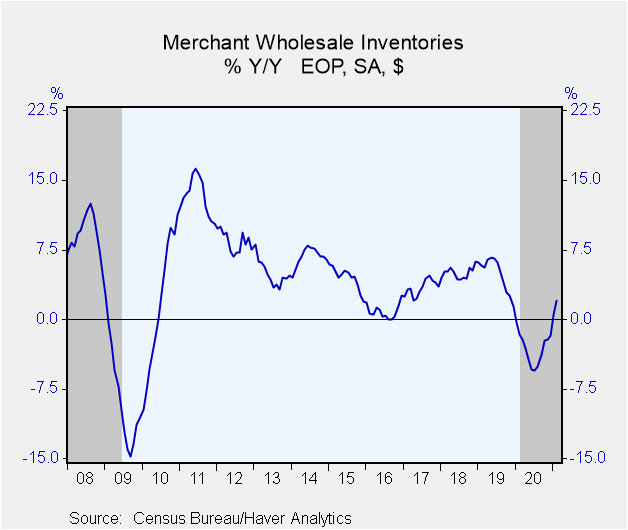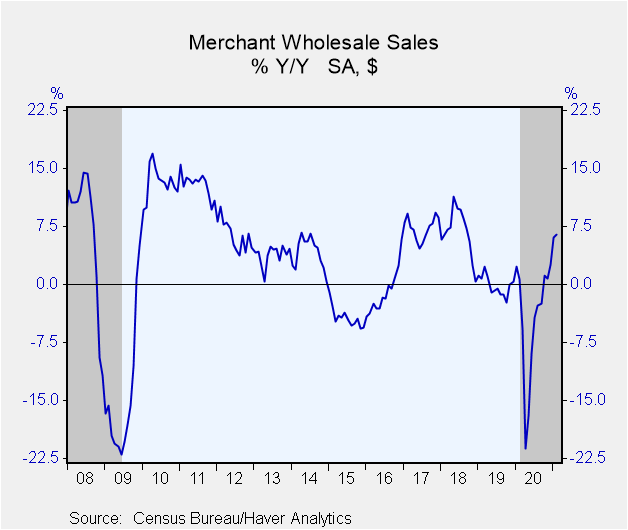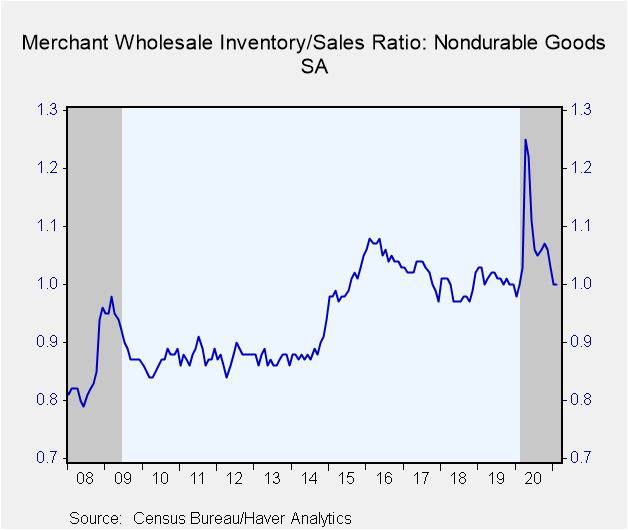 Global| Apr 09 2021
Global| Apr 09 2021U.S. Wholesale Inventories Post Strong February Gain; Sales Fall
by:Tom Moeller
|in:Economy in Brief
Summary
• Wholesale inventory strength reflects higher oil prices. • Decline in sales helps to raise I/S ratio. Wholesale inventories increased 0.6% (2.0% y/y) during February following a 1.4% January jump, revised from 1.3%. A 0.5% gain had [...]
• Wholesale inventory strength reflects higher oil prices.
• Decline in sales helps to raise I/S ratio.
Wholesale inventories increased 0.6% (2.0% y/y) during February following a 1.4% January jump, revised from 1.3%. A 0.5% gain had been expected in the Informa Global Markets Survey. Data for 2020 were revised.
Durable goods inventories rose 0.3% in February (-0.5% y/y) following a 1.3% January rise. Computer & peripheral equipment led the gain with a 0.9% rise (8.2% y/y) which followed three months of even stronger increases. Hardware and plumbing & heating equipment inventories were also strong, up 0.8% (7.7% y/y). Motor vehicles inventories eased 0.6% (-4.6% y/y) while machinery inventories edged 0.1% higher (-4.3% y/y). Nondurables inventories rose 1.1% (6.0% y/y) as petroleum inventories surged 8.1% (20.8% y/y) with higher prices. Chemical inventories rose 0.5% (-1.3% y/y) but apparel inventories jumped 6.0% (-9.2% y/y). They had been falling sharply since June 2020.
Wholesale sales declined 0.8% during February (+6.4% y/y) after strengthening 4.4% in January, revised from 4.9%. A 2.2% decline was anticipated in the Action Economics Forecast Survey. Durable goods sales weakened 2.2% (+7.2% y/y) as furniture & home furnishings sales fell 2.2% (+0.3% y/y). Auto sales declined 5.0% (+2.1% y/y). That decline was accompanied by a 0.3% rise (5.8% y/y) in electronic goods sales. Nondurable wholesale sales rose 0.5% (5.7%) but petroleum product shipments jumped 9.3% (6.7% y/y) as oil prices increased. Paper sales fell 4.3% (-3.0% y/y) but sales of chemicals & allied products rose 0.4% (0.7% y/y). Apparel sales declined 6.5% (-10.3% y/y).
The inventory-to-sales (I/S) ratio at the wholesale level rose to 1.27 in February from 1.25, matching the low in May 2018. This ratio is well below a record high of 1.66 in April of last year (figures date back to 1980). The durable goods I/S ratio rose to 1.55 from a nine-month low of 1.51. The nondurable I/S ratio held steady at 1.00, below last April's record high of 1.25.
The wholesale trade figures and oil prices are available in Haver's USECON database. The expectations figure for inventories is contained in the MMSAMER database. Expectations for sales are in the AS1REPNA database.
| Wholesale Sector - NAICS Classification (%) | Feb | Jan | Dec | Feb Y/Y | 2020 | 2019 | 2018 |
|---|---|---|---|---|---|---|---|
| Inventories | 0.6 | 1.4 | 0.3 | 2.0 | -1.2 | 1.4 | 6.1 |
| Sales | -0.8 | 4.4 | 1.4 | 6.4 | -4.3 | -0.2 | 7.0 |
| I/S Ratio | 1.27 | 1.25 | 1.29 | 1.32 (Feb'20) | 1.37 | 1.35 | 1.29 |
Tom Moeller
AuthorMore in Author Profile »Prior to joining Haver Analytics in 2000, Mr. Moeller worked as the Economist at Chancellor Capital Management from 1985 to 1999. There, he developed comprehensive economic forecasts and interpreted economic data for equity and fixed income portfolio managers. Also at Chancellor, Mr. Moeller worked as an equity analyst and was responsible for researching and rating companies in the economically sensitive automobile and housing industries for investment in Chancellor’s equity portfolio. Prior to joining Chancellor, Mr. Moeller was an Economist at Citibank from 1979 to 1984. He also analyzed pricing behavior in the metals industry for the Council on Wage and Price Stability in Washington, D.C. In 1999, Mr. Moeller received the award for most accurate forecast from the Forecasters' Club of New York. From 1990 to 1992 he was President of the New York Association for Business Economists. Mr. Moeller earned an M.B.A. in Finance from Fordham University, where he graduated in 1987. He holds a Bachelor of Arts in Economics from George Washington University.










